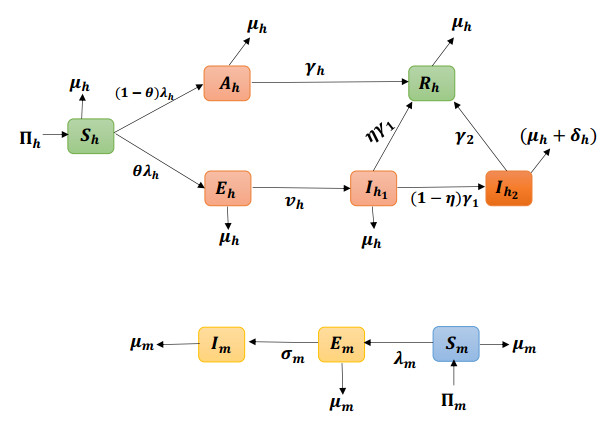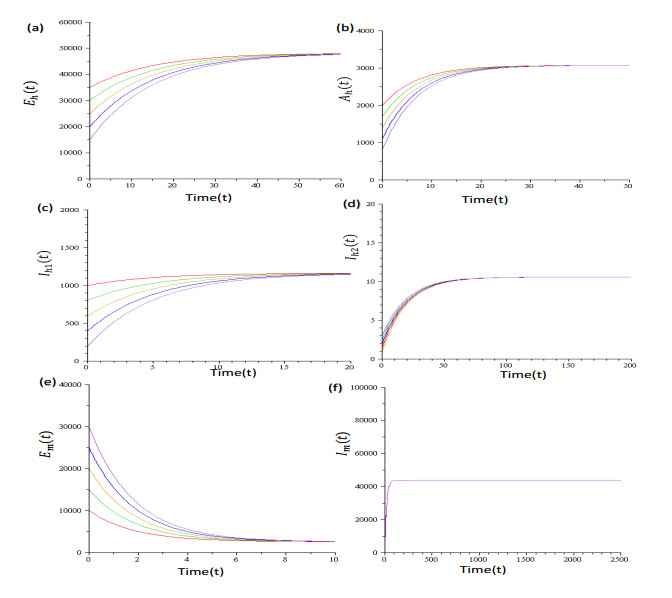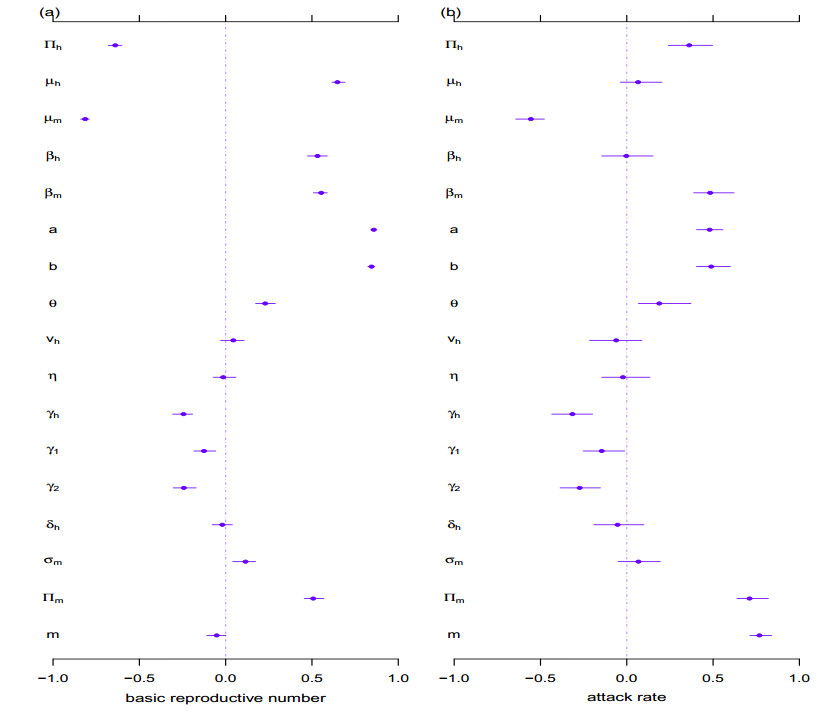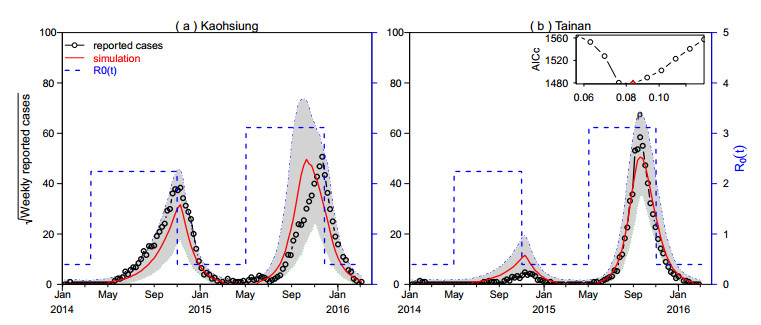Dengue virus (DENV) infection is endemic in many places of the tropical and subtropical regions, which poses serious public health threat globally. We develop and analyze a mathematical model to study the transmission dynamics of the dengue epidemics. Our qualitative analyzes show that the model has two equilibria, namely the disease-free equilibrium (DFE) which is locally asymp- totically stable when the basic reproduction number (R0) is less than one and unstable if R0 > 1, and endemic equilibrium (EE) which is globally asymp-totically stable when R0 > 1. Further analyzes reveals that the model exhibit the phenomena of backward bifurcation (BB) (a situation where a stable DFE co-exists with a stable EE even when the R0 < 1), which makes the disease control more diffi-cult. The model is applied to the real dengue epidemic data in Kaohsiung and Tainan cities in Taiwan, China to evaluate the fitting performance. We propose two reconstruction approaches to estimate the time-dependent R0, and we find a consistent fitting results and equivalent goodness-of-fit. Our findings highlight the similarity of the dengue outbreaks in the two cities. We find that despite the proximity in Kaohsiung and Tainan cities, the estimated transmission rates are neither completely synchronized, nor periodically in-phase perfectly in the two cities. We also show the time lags between the seasonal waves in the two cities likely occurred. It is further shown via sensitivity analysis result that proper sanitation of the mosquito breeding sites and avoiding the mosquito bites are the key control measures to future dengue outbreaks in Taiwan.
1.
Introduction
In 1960, Opial [12] established the following inequality:
Theorem A Suppose f∈C1[0,h] satisfies f(0)=f(h)=0 and f(x)>0 for all x∈(0,h). Then the inequality holds
where this constant h/4 is best possible.
Many generalizations and extensions of Opial's inequality were established [2,4,5,6,7,8,9,10,11,15,16,17,18,19]. For an extensive survey on these inequalities, see [13]. Opial's inequality and its generalizations and extensions play a fundamental role in the ordinary and partial differential equations as well as difference equation [2,3,4,6,7,9,10,11,17]. In particular, Agarwal and Pang [3] proved the following Opial-Wirtinger's type inequalities.
Theorem B Let λ≥1 be a given real number, and let p(t) be a nonnegative and continuous function on [0,a]. Further, let x(t) be an absolutely continuous function on [0,a], with x(0)=x(a)=0. Then
The first aim of the present paper is to establish Opial-Wirtinger's type inequalities involving Katugampola conformable partial derivatives and α-conformable integrals (see Section 2). Our result is given in the following theorem, which is a generalization of (1.2).
Theorem 1.1 Let λ≥1 be a real number and α∈(0,1], and let p(s,t) be a nonnegative and continuous functions on [0,a]×[0,b]. Further, let x(s,t) be an absolutely continuous function and Katugampola partial derivable on [0,a]×[0,b], with x(s,0)=x(0,t)=x(0,0)=0 and x(a,b)=x(a,t)=x(s,b)=0. If p>1, 1p+1q=1 Then
where
Remark 1.1 Let x(s,t) reduce to s(t) and with suitable modifications, and p=q=2 and α=1, (1.3) become (1.2).
Theorem C Let λ≥1 be a given real number, and let p(t) be a nonnegative and continuous function on [0,a]. Further, let x(t) be an absolutely continuous function on [0,a], with x(0)=x(a)=0. Then
Another aim of this paper is to establish the following inequality involving Katugampola conformable partial derivatives and α-conformable integrals. Our result is given in the following theorem.
Theorem 1.2 Let j=1,2 and λ≥1 be a real number, and let pj(s,t) be a nonnegative and continuous functions on [0,a]×[0,b]. Further, let xj(s,t) be an absolutely continuous function and Katugampola partial derivable on [0,a]×[0,b], with xj(s,0)=xj(0,t)=xj(0,0)=0 and xj(a,b)=xj(a,t)=xj(s,b)=0. Then for α∈(0,1]
2.
Katugampola conformable partial derivatives
Here, let's recall the well-known Katugampola derivative formulation of conformable derivative of order for α∈(0,1] and t∈[0,∞), given by
and
provided the limits exist. If f is fully differentiable at t, then
A function f is α-differentiable at a point t≥0, if the limits in (2.1) and (2.2) exist and are finite. Inspired by this, we propose a new concept of α-conformable partial derivative. In the way of (1.4), α-conformable partial derivative is defined in as follows:
Definition 2.1 [20] (α-conformable partial derivative) Let α∈(0,1] and s,t∈[0,∞). Suppose f(s,t) is a continuous function and partial derivable, the α-conformable partial derivative at a point s≥0, denoted by ∂∂s(f)α(s,t), defined by
provided the limits exist, and call α-conformable partial derivable.
Recently, Katugampola conformable partial derivative is defined in as follows:
Definition 2.2 [20] (Katugampola conformable partial derivatives) Let α∈(0,1] and s,t∈[0,∞). Suppose f(s,t) and ∂∂s(f)α(s,t) are continuous functions and partial derivable, the Katugampola conformable partial derivative, denoted by ∂2∂s∂t(f)α2(s,t), defined by
provided the limits exist, and call Katugampola conformable partial derivable.
Definition 2.3 [20] (α-conformable integral) Let α∈(0,1], 0≤a<b and 0≤c<d. A function f(x,y):[a,b]×[c,d]→R is α-conformable integrable, if the integral
exists and is finite.
3.
Main results
Theorem 3.1 Let λ≥1 be a real number and α∈(0,1], and let p(s,t) be a nonnegative and continuous functions on [0,a]×[0,b]. Further, let x(s,t) be an absolutely continuous function and Katugampola partial derivable on [0,a]×[0,b], with x(s,0)=x(0,t)=x(0,0)=0 and x(a,b)=x(a,t)=x(s,b)=0. If p>1, 1p+1q=1 Then
where
Proof From (2.4) and (2.5), we have
By using Hölder's inequality with indices λ and λ/(λ−1), we have
Similarly, from
we obtain
Now a multiplication of (3.2) and (3.3), and by using the well-known Young inequality gives
where
Multiplying the both sides of (3.4) by p(s,t) and α–conformable integrating both sides over t from 0 to b first and then integrating the resulting inequality over s from 0 to a, we obtain
This completes the proof.
Remark 3.1 Let x(s,t) reduce to s(t) and with suitable modifications, (3.1) becomes the following result.
where Dα(x)(t) is Katugampola derivative (2.1) stated in the introduction, and
Putting p=q=2 and α=1 in (3.5), (3.5) becomes inequality (1.2) established by Agarwal and Pang [3] stated in the introduction.
Taking for α=1, p=q=2 and p(s,t)=constant in (3.1), we have the following interesting result.
where B is the Beta function.
Theorem 3.2 Let j=1,2 and λ≥1 be a real number, and let pj(s,t) be a nonnegative and continuous functions on [0,a]×[0,b]. Further, let xj(s,t) be an absolutely continuous function and Katugampola partial derivable on [0,a]×[0,b], with xj(s,0)=xj(0,t)=xj(0,0)=0 and xj(a,b)=xj(a,t)=xj(s,b)=0. Then for α∈(0,1]
Proof Because
Hence
By Hölder's inequality with indices λ and λ/(λ−1), it follows that
Similarly
Taking the sum of (3.7) and (3.8) and α-integrating the resulting inequalities over t from 0 to b first and then over s from 0 to a, we obtain
Remark 3.2 Taking for x1(s,t)=x2(s,t)=x(s,t) and p1(s,t)=p2(s,t)=p(s,t) in (3.6), (3.6) changes to the following inequality.
Putting α=1 in (3.9), we have
Let x(s,t) reduce to s(t) and with suitable modifications, and λ=1, (2.10) becomes the following result.
This is just a new inequality established by Agarwal and Pang [4]. For λ=2 the inequality (3.11) has appear in the work of Traple [14], Pachpatte [13] proved it for λ=2m (m≥1 an integer).
Remark 3.3 Let xj(s,t) reduce to xj(t) (j=1,2) and pj(s,t) reduce to pj(t) (j=1,2) with suitable modifications, (3.6) becomes the following interesting result.
Putting λ=1 and α=1 in (3.12), we have the following interesting result.
Finally, we give an example to verify the effectiveness of the new inequalities. Estimate the following double integrals:
where λ≥1.
Let x1(s,t)=x2(s,t)=x(s,t)=st(s−1)(t−1), p1(s,t)=p2(s,t)=p(s,t)=(st)1−α, a=b=1 and 0<α≤1, and by using Theorem 3.2, we obtain
4.
Conclusions
We have introduced a general version of Opial-Wirtinger's type integral inequality for the Katugampola partial derivatives. The established results are generalization of some existing Opial type integral inequalities in the previous published studies. For further investigations we propose to consider the Opial-Wirtinger's type inequalities for other partial derivatives.
Acknowledgments
I would like to thank that research is supported by National Natural Science Foundation of China(11471334, 10971205).
Conflict of interest
The author declares no conflicts of interest.

















 DownLoad:
DownLoad: